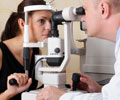Dry eye syndrome (DES) is a condition characterized by an insufficiency in the amount or quality of tears.
Dry eye syndrome (DES) is a condition characterized by an insufficiency in the amount or quality of tears. For the millions of Americans who do suffer from DES, it can get in the way of daily living.
Our eyes need tears to keep them healthy. In most people, a constant tear film lubricates and protects the eyes. In people with DES, a decreased production of fluid can weaken the tear film, causing the eye to become dry, irritated and uncomfortable.In a recent study published in the American Journal of Ophthalmology, researchers discovered that DES can have a considerable and detrimental effect on everyday life for people who suffer from the condition. The study of about 700 people found that sufferers of DES were more likely to report problems with daily activities, including reading, using a computer, driving and watching television, than people without DES. The researchers concluded that DES may be more of a public health problem than previously realized.
Dry eye symptoms usually first appear in adults over the age of 40, but they can appear in individuals between the ages of 20 and 30.
Women are approximately two to three times more likely to get DES than men. “We do not know all of the reasons why,” said Dr. Debra Schaumberg, author of the study and director of ophthalmic epidemiology at Brigham and Women’s Hospital in Boston, Mass. “However, there is speculation that one of the chief reasons might be that sex steroid hormones are involved in the pathogenesis of the disease.”
Other reasons women may be disproportionately affected by DES include the balance of female and male sex hormones. “There are data to support the hypothesis that androgens (male sex hormones) are protective whereas estrogens (female sex hormones) appear to play a more detrimental role,” Schaumberg said.
Despite the fact that DES is one of the most common reasons people seek care from eye doctors, it may be clinically disregarded. “DES is relatively overlooked because it is not on the short list of major causes of blindness and visual impairment,” Schaumberg said.
Advertisement
If the symptoms persist, they can present other problems for sufferers. According to Schaumberg, “people with DES are bothered by irritative ocular symptoms which can be likened to other chronic pain syndromes wherein such ongoing problems may also lead to a general sense of ill health or psychological comorbidities.” In other words, persistent DES symptoms can be as debilitating as other chronic illnesses and lead to larger physical and emotional health problems.
Advertisement
Current treatments include eye drops, artificial tear solutions, anti-inflammatory agents, topical steroids, procedures to plug the tear ducts and surgery. Research into new treatments is on the horizon. According to Latkany, “at least a dozen new drugs are in development and testing, ready for release in the near future.”
Source-Newswise
SRM











